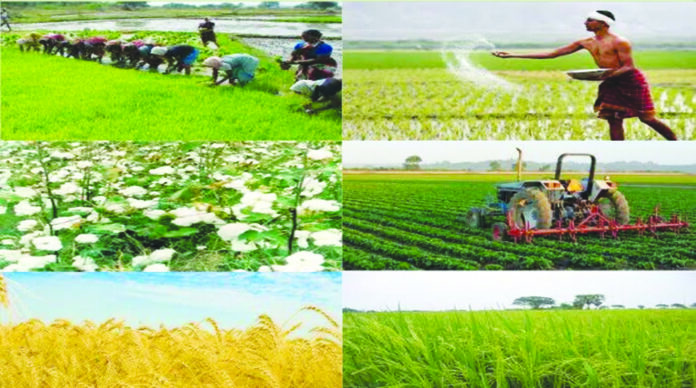Agriculture is an art of nurturing harvest and hoisting livestock. Its paramount economic role in undersized or budding countries has vital significance. In Pakistan it has been considered an economic axis for growth. In the 40s, it made up around 53% of the country’s GDP and more than 65% of our labor engaged in this sector. During the last 7 decades, political, social, environmental and climate change have curtailed these figures to decline. Currently, agriculture is contributing 22.04% to national GDP. The agro-employment ratio has fallen from 65% to mere 35.9%. The national rural population is around 63.09% and overwhelming preponderance of the bucolic is unswervingly or circuitously connected with agriculture. It also supplies unrefined material for the various industrial sectors as well as a chief purchaser of agro-products. Ironically, we are only cultivating 21.1 million of the area out of 796,096km, which is why roughly 1/3rd of our population lives below the poverty line approximately, around 49% of our people are facing food insecurity. It is anticipated that the wheat production will decline by 50% in 2050 owing to climate change. Climate change has drastically affected our mango production. Despite all this we are one of the largest producers of chief crops contributing to around 35% of agriculture, livestock contributes to around 61% in agriculture, fisheries contribute 2.06% and forestry contribute 2.13% in agriculture.
Crops production had negative growth in 2015, 2016 and 2019, Forestry saw a gigantic beg off in 2015 and downbeat growth of 2.33% in 2017. Wheat is one of the most used crops in the world. During 2020, it contributed 8.7% in agriculture and 1.7% in GDP of the country. In 2019-2020, despite covid-19 and locust attacks Pakistan managed to produce 24.9 million tons of wheat and the area for wheat cultivation also increased by 1.7%. Rice is the second most vital crop in terms of food, cash and export. It contributes to 3.1% of agriculture and 0.6% to national GDP. In 2020, Pakistan produced 7.4 million tons of rice and the area of cultivation also increased by 8%. Cotton is also considered the backbone of our economy. It contributes to 4.1% of agriculture and 0.8% to the GDP of the country; in 2019-20 we produced 9.1 million bales of cotton, the 7% production of cotton decreased by almost 7% from the output of 2018-19. The area of cultivation was increased by 6.5% but the overall output decreased in 2019-20. Sugarcane is very significant for the sugar related industries. The Sugar Mafia and the sugar crisis had been rampant some months before. Sugarcane contributes to 2.9% of agriculture and0.6% to the GDP of the country, in 2019-20, the production of sugarcane declined by 0.4% and the area under cultivation fell by 5.6%. The negligence in sugar production resulted in a severe sugar crisis. Maize contributes to 2.9% of total agriculture and 0.6% to national GDP. The area of cultivation was increased by 2.9% in 2019-20 and its production increased by 7%. The increase is due to allocation of more area and better seeds.
The production of gram, Bajra and Tobacco boosted by 21.9%, 9.7% and 5.8% in the year 2019-20 respectively, while the production of Jowar declined by 19.5%. As for the pulses the production of moong increased by 12.6%, mash decreased by 5.8% and the production of masoor remained stable. Production of chilies increased by 34.6%, due to the good weather conditions but the production of onions and potatoes decreased by 1% and 5.3% in the year 2019-20. The production of oil from oilseeds was only 0.5 million tons. More than 8million families are directly or indirectly linked with this livestock sector and it is the source of 35-40% of their income. Livestock also contributes to 3.1% of our exports. 960.6% of total agriculture is based upon livestock and it contributes to 11.7% of our national GDP. Globally, Pakistan is the fourth largest milk producer. In 2019-20 we produced 61.6 million tons of milk and 4.7 million tones of meat. Poultry is a subsector of livestock, currently the investment in this sector has reached 700 billion rupees and the sector provides jobs to around 1.5 million people in the country.
In 2019-2020, despite covid-19 and locust attacks Pakistan managed to produce 24.9 million tons of wheat and the area for wheat cultivation also increased by 1.7%. Rice is the second most vital crop in terms of food, cash and export.
This sector balances the overall meat production of the country as 35% of the total meat comes from poultry. This sector grew by 9.1% in 2019-20. Fisheries is the source of income for the people living in coastal areas of Pakistan. It has a 0.4% share in GDP. In 2019-20 the total fisheries production was approximately 701762 metric tons and we exported Rs 49528 million worth of fishes and fish products. There is an overall increase in production, in comparison to 2018-19 was 9.7%, whereas the overall increase in the exports of fish and fish related products was 2.7%. Forestry is very important but unluckily only 5.01% area of Pakistan comprises forest. The country has 4.51 million hectares of forest, in which 3.44 millions of forests are on government owned land, the rest are on private owned lands. The share of forestry is only 2.1%. The results indicate that Agriculture and subsectors of Agriculture had a significant impact on economic growth of the country; however forestry did not have a significant impact on economic growth. There is a dire need of turning our lens to agro-economic development. AJK and GB must be kept on focal points in this respect as there are greater prospects of agro-economic growth and contribution to national GDP. In AJK and GB most of the areas are uncultivated and uninhabited. The industry of livestock can bring a tremendous change to boost a country’s economy and the living standard of the masses. Agro-economic sector needs immediate attention of the concerned authorities to tackle the future problems which may get worse in case of further delay.























